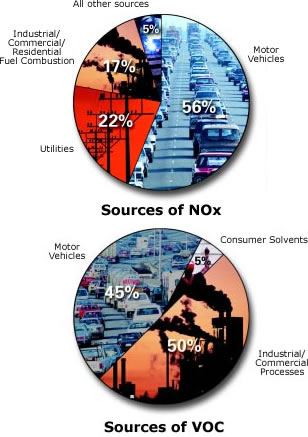Bad Nearby
Ground-level or "bad" ozone is not emitted directly into the air, but is created by chemical reactions between oxides of nitrogen (NOx) and volatile organic compounds (VOC) in the presence of sunlight. Emissions from industrial facilities and electric utilities, motor vehicle exhaust, gasoline vapors, and chemical solvents are some of the major sources of NOx and VOC.
 |
At ground level, ozone is a harmful pollutant. Ozone pollution is a concern during the summer months because strong sunlight and hot weather result in harmful ozone concentrations in the air we breathe. Many urban and suburban areas throughout the United States have high levels of "bad" ozone. But many rural areas of the country are also subject to high ozone levels as winds carry emissions hundreds of miles away from their original sources.
How Does "Bad" Ozone Affect Human Health and the Environment?
Breathing ozone can trigger a variety of health problems including chest pain, coughing, throat irritation, and congestion. It can worsen bronchitis, emphysema, and asthma. "Bad" ozone also can reduce lung function and inflame the linings of the lungs. Repeated exposure may permanently scar lung tissue.
Healthy people also experience difficulty breathing when exposed to ozone pollution. Because ozone forms in hot weather, anyone who spends time outdoors in the summer may be affected, particularly children, outdoor workers and people exercising. Millions of Americans live in areas where the national ozone health standards are exceeded.
Ground-level or "bad" ozone also damages vegetation and ecosystems. It leads to reduced agricultural crop and commercial forest yields, reduced growth and survivability of tree seedlings, and increased susceptibility to diseases, pests and other stresses such as harsh weather. In the United States alone, ground-level ozone is responsible for an estimated $500 million in reduced crop production each year. Ground-level ozone also damages the foliage of trees and other plants, affecting the landscape of cities, national parks and forests, and recreation areas.
What Is Being Done About "Bad" Ozone?
Under the Clean Air Act, EPA has set protective health-based standards for ozone in the air we breathe. EPA, state, and cities have instituted a variety of multi-faceted programs to meet these health-based standards. Throughout the country, additional programs are being put into place to cut NOx and VOC emissions from vehicles, industrial facilities, and electric utilities. Programs are also aimed at reducing pollution by reformulating fuels and consumer/commercial products, such as paints and chemical solvents, that contain VOC. Voluntary programs also encourage communities to adopt practices, such as carpooling, to reduce harmful emissions.
| We live with ozone every day. It can protect life on earth or harm it, but we have the power to influence ozone's impact by the way we live. |
![[logo] US EPA](https://webarchive.library.unt.edu/eot2008/20090512051300im_/http://www.epa.gov/epafiles/images/logo_epaseal.gif)